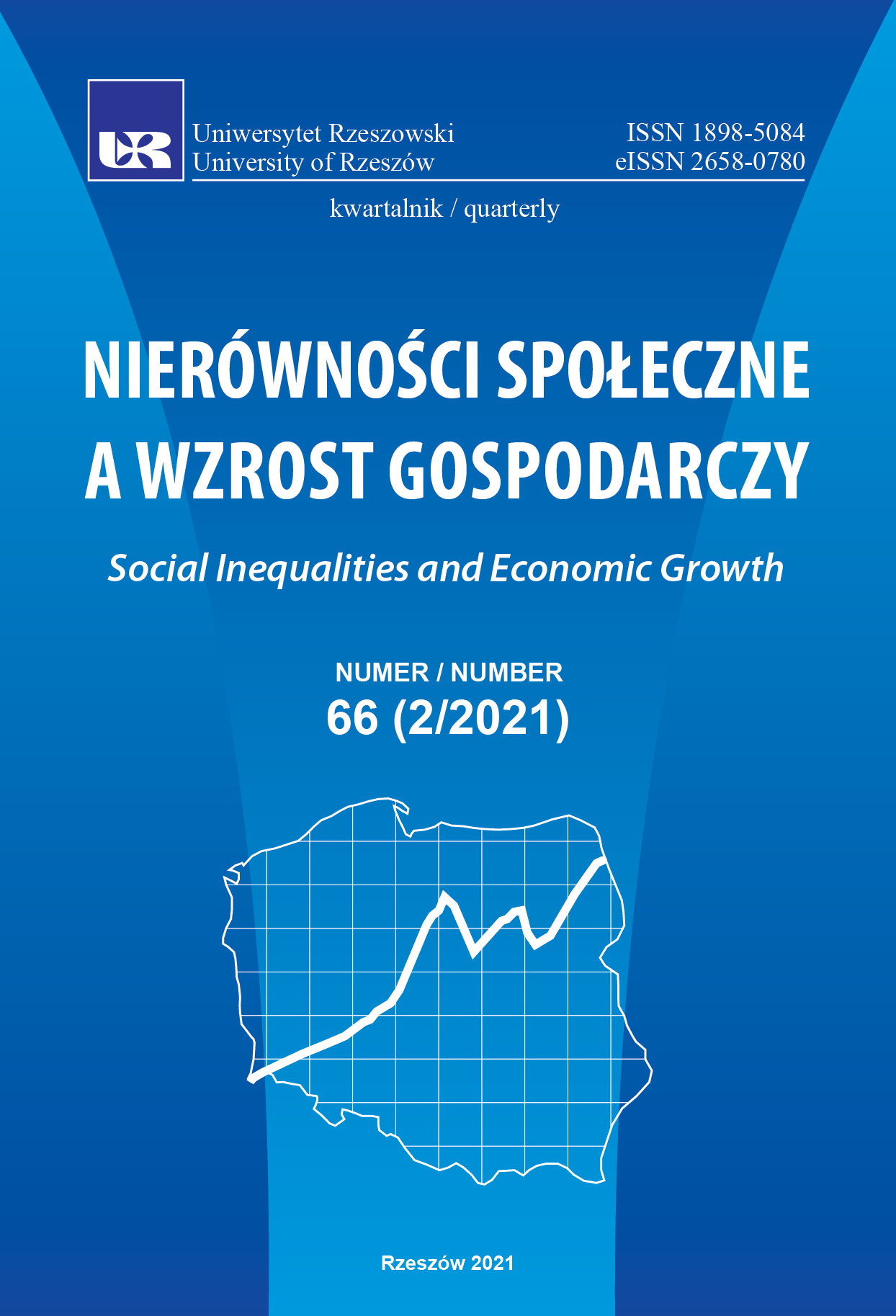Selected concepts in measuring income inequality
DOI:
https://doi.org/10.15584/nsawg.2021.2.2Keywords:
income inequalities, measurement, methodologyAbstract
Determining the level of income inequality requires the adoption of a specific measurement methodology. The aim of the study was to review and discuss the methodologies used to measure income inequality. Four measures are presented, each based on different assumptions. These measures were the Gini coefficient, Theil coefficient, Kukuła coefficient and unevenness coefficient. The firs three measures, and in particular the Gini coefficient, are commonly described in the literature, while the unevenness coefficient is the author’s proposal for measuring income inequality. The empirical material for the research consists of data on the distribution of disposable income by decile groups in households in Poland for the years 2005–2017.
The most important issue in practice regarding the measurement of income inequality was the transfer principle. Depending on the methodology adopted, the transfer of income is treated differently The Gini, Theil and Kukula coefficients respond to any change in the income distribution, while the unevenness coefficient only to changes above the average. In a situation where the Gini coefficie (Theil and Kukula) decreases (increases), the level of inequality decreases (increases), but it is not known which transfers led to such a result. The decreasing (growing) unevenness coefficient means that these were transfers from groups with shares in income above (below) the average for groups with shares below (above) the average.
Downloads
References
Allison, P. (1978). Measures of Inequality. American Sociological Review, 43, 865–880. DOI: 10.2307/2094626.
Arneson, R. (2000). Luck egalitarianism and prioritarianism. Ethics, 110, 339–349. DOI: 10.1086/233272.
Atkinson, A. B. (1983). The Economics of Inequality. Oxford: Clarendon Press.
Cohen, G. A. (1989). On the Currency of Egalitarian Justice. Ethics, 99, 906–944. DOI:10.1086/293126.
Czempas, J. (2012). Współczynnik koncentracji K jako miara zróżnicowania dochodów i inwestycji gmin. Metody Ilościowe w Badaniach Ekonomicznych, XIII/1, 69–81.
Domański, H. (2007). Struktura społeczna. Warszawa: Scholar.
Duclos, J-Y., Esteban, J., Ray, D. (2004). Polarization: Concepts, Measurement, Estimation. Econometrica, 72 (6), 1737–1772. DOI: 10.1111/j.1468-0262.2004.00552.x.
Dworkin, R. (2000). What Is Equality? I. Equality of Welfare. W: R. Dworkin, Sovereign Virtue: The Theory and Practice of Equality. Harvard: Harvard University Press.
Dworkin, R. (2002). Sovereign Virtue Revisited. Ethics, 113(1), 106–143. DOI: 10.1086/341579.
Fogelson, S. (1933). Miary koncentracji i ich zastosowania. Kwartalnik Statystyczny, X, 1, 149–197.
Gosepath S. (2007). Equality. W: Edward N. Zalta (red.), The Stanford Encyclopedia of Philosophy (Winter 2009 Edition).
Horrighan, H., Haugen, S. (1988). The Declining Middle Class: a Sensitivity Analysis. Monthly Labour Review, 111, 3–13.
Kharas, H., Gertz, G. (2010). The New Global Middle Class: A Cross-Over from West to East. W: Cheng Li (red.), China’s Emerging Middle Class: Beyond Economic Trans formation. Washington: Brookings Institution Press.
Kleiber, Ch., Kotz, S. (2003). Statistical Size Distributions in Economics and Actuarial Sciences. Hoboken, New Jersey: John Wiley & Sons, Inc.
Kot, M. S., Malawski, A., Węgrzecki, A. (2004). Dobrobyt społeczny, nierówności i sprawiedliwość dystrybutywna. Kraków: Wydawnictwo Akademii Ekonomicznej w Krakowie.
Kukuła, K. (1996). Statystyczne metody analizy struktur ekonomicznych. Kraków: Wydawnictwo Edukacyjne.
Leszczyńska, M. (2013). Spójność społeczno-ekonomiczna a regionalne zróżnicowanie gospodarstw domowych w Polsce w świetle wybranych wskaźników społecznych. Nierówności Społeczne a Wzrost Gospodarczy, 34, 134–143.
Panek, T. (2011). Ubóstwo, wykluczenie społeczne i nierówności. Teoria i praktyka pomiaru. Warszawa: Oficyna Wydawnicza SGH.
Panek, T. (2017). Polaryzacja ekonomiczna w Polsce. Wiadomości Statystyczne, 1(668), 41–61.
Radziukiewicz, M. (2006). Nierówności dochodowe gospodarstw domowych. Wiadomości Statystyczne, 10, 45–61.
Rawls, J. (1994). Teoria sprawiedliwości. Warszawa: Wydawnictwo Naukowe PWN.
Sączewska-Piotrowska, A. (2005). Nierówności dochodowe gospodarstw domowych. Wiadomości Statystyczne, 6, 54–63.
Sen, A. (2000). Nierówności. Dalsze rozważania. Kraków: Znak.
Shorrocks, A., Wan, G. (2005). Spatial decomposition of inequality. Journal of Economic Geography, 5, 59–81. DOI: 10.1093/jnlecg/lbh054.
Szulc, S. (1963). Metody statystyczne. Warszawa: Państwowe Wydawnictwo Ekonomiczne.
Wiśniewski, J. (1929). Rozkład dochodów według wysokości w roku 1929. Warszawa: Instytut Badania Koniunktur Gospodarczych i Cen.
Włodarczyk, J. (2013). Nierówności dochodowe w Polsce według rozkładów Pareto i Boltzmanna-Gibbsa. Studia Ekonomiczne, 130, Problemy gospodarki rynkowej: Polska i świat, 76–87.
Wojnar, K. (2011). Wpływ polityki spójności na spójność społeczną polskich miast – wnioski z badań ewaluacyjnych. Studia Regionalne i Lokalne, wydanie specjalne 2011, 67–83.
Wołoszyn, A., Głowicka-Wołoszyn, R. (2015). Nierówności dochodowe gospodarstw domowych w Polsce w kontekście zrównoważonego rozwoju. Prace Naukowe Uniwersytetu Ekonomicznego we Wrocławiu, 395. Tom 1. Finanse, 396–407. DOI: 10.15611/pn.2015.395.37.
Zwiech, P. (2017). Eliminacja nierówności społeczno-ekonomicznych jako cel polityki spójności. Studia Ekonomiczne, 310,128–136.
Downloads
Published
How to Cite
Issue
Section
License

This work is licensed under a Creative Commons Attribution-ShareAlike 4.0 International License.


